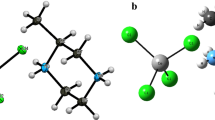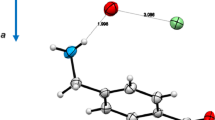Abstract
Ab initio calculations were used to analyze the interaction of C4B2H6 with HF and LiH molecules at the mp2/6-311++g(2d,2p) computational level. Interaction of C4B2H6 with HF results to H–F···H–C and C–B···H–F, C–C···H–F hydrogen bond as well as B–H···H–F dihydrogen bond complexes. Also interaction of C4B2H6 with LiH results to B–C···LiH, C–C···LiH and B–H···LiH lithium bond as well as C–H···H–Li dihydrogen complexes. In the both cases, complexes involving interaction of HF or LiH with peripheral B–C and C–C bonds of the C4B2H6 backbone have greater stabilities. The structures of complexes have been analyzed using AIM and NBO methodologies.


Similar content being viewed by others
References
Grimes Russell N (2011) Carboranes, 2nd edn. Academic Press, London
Hosmane NS (2011) Boron science: new technologies and applications. Taylor & Francis Books/CRC Press, Boca Raton
Spokoyny AM, Farha OK, Mulfort KL, Hupp JT, Mirkin CA (2010) Porosity tuning of carborane-based metal–organic frameworks (MOFs) via coordination chemistry and ligand design. Inorg Chim Acta 364:266–271
Eo M, Park MH, Kim T, Do Y, Lee MH (2013) Polynorbornene copolymers with pendent o-carborane and carbazole groups: novel side-chain donor–acceptor copolymers for turn-on sensing of nucleophilic anions. Polymer 54:6321–6328
Zou HY, Ma NN, Sun SL, Li X, Qiu YQ (2013) Structures and redox-switchable second-order nonlinear optics properties of N-legged piano stool shaped 12-vertex rhenacarborane half-sandwich complexes. J Organomet Chem 728:6–15
Liu Y, Yang G, Sun S, Su Z (2012) Theoretical investigation on two-dimensional molecule-based second-order nonlinear optical materials of the disubstituted o-carborane derivatives. Comput Theor Chem 992:142–149
Valliant JF, Guenther KJ, King AS, Morel P, Schaffer P, Sogbein OO, Stephenson KA (2002) The medicinal chemistry of carboranes. Coord Chem Rev 232:173–230
Calabrese G, Nesnas JJ, Barbu E, Fatouros D, Tsibouklis J (2012) The formulation of polyhedral boranes for the boron neutron capture therapy of cancer. Drug Discovery Today 17:153–159
Białek-Pietras M, Olejniczak AB, Tachikawa S, Nakamura H, Leśnikowski ZJ (2013) towards new boron carriers for boron neutron capture therapy, Metallacarboranes bearing cobalt, iron and chromium and their cholesterol conjugates. Bioorg Med Chem 21:1136–1142
Pasinski JP, Beaudet RA (1974) Microwave spectrum, structure, and dipole moment of 2,3,4,5-tetracarbahexaborane(6). J Chem Phys 61:683
Haase J (1973) The Molecular Structure of Hexamethyl-tetracarbahexaborane(6). Z. Naturforsch. A 28:785
Dewar MJS, Jie C, Zoebisch EG (1988) AM1 calculations for compounds containing boron. Organometallics 7:513
Epstein IR, Tossell JA, Switkes E, Stevens RM, Lipscomb WN (1971) Hexaborane (10): self consistent field wavefunction, localized orbitals and relationships to chemical properties. Inorg Chem 10:171
Tian SX (2005) Theoretical study of isoelectronic molecules: B6H10, 2-CB5H9, 2,3-C2B4H8, 2,3,4-C3B3H7, and 2,3,4,5-C4B2H6. J Phys Chem A 109:6580
Gill WR, Jones ME, Wade K, Porterfield WW, Wong EH (1992) Stability patterns in borane cluster chemistry rationalized by extended Hückel molecular orbital studies. J. Mol. Struct. (Theochem) 261:161
Hofmann M, Fox MA, Greatrex R, Schleyer PVR, Williams RE (2001) Empirical and ab initio energy/architectural patterns for 73 nido-6 <V>-carborane isomers, from B(6)H(9)(−) to C(4)B(2)H(6). Inorg Chem 40:1790
Alkorta I, Rozas I, Elguero J (1998) Non-conventional hydrogen bonds. J. Chem. Soc. Rev. 27:163
Desiraju GR, Steiner T (1999) The weak hydrogen bond. Oxford University Press, Oxford
Nie Y, Miao J, Pritzkow H, Wadepohl H, Siebert W (2013) Weak intramolecular C–H···H–B and C–H···Cl interactions in C-aminoboryl-o-carboranes. J Organomet Chem 747:174–177
Kononova EG (2013) Electronic structure of 10-vertex arachno-borane and—carborane clusters. Comput Theor Chem 1026:17–23
Solimannejad M, Amlashi LM, Alkorta I, Elguero J (2006) XeH2 as a proton-accepting molecule for dihydrogen bonded systems: a theoretical study. J Chem Phys Lett 422:226
Alkorta I, Zborowski K, Elguero J, Solimannejad M (2006) Theoretical study of dihydrogen bonds between (XH)2, X = Li, Na, BeH, and MgH, and weak hydrogen bond donors (HCN, HNC, and HCCH). J Phys Chem A 110:10279
Zabardasti A, Arabpour M (2012) Theoretical study of hydrogen and dihydrogen bond interaction of B6H10 with the HF molecule. Struct Chem 23:473–477
Zabardasti A, Arabpour M, Zare Nahid (2013) Theoretical study of hydrogen and dihydrogen bond interaction of B5H11 with the HF and LiH molecules. Comput Theor Chem 1008:27–31
Zabardasti A, Zare N, Arabpour M, Kakanejadifard A, Solimannejad M (2013) Theoretical study of mixed hydrogen and dihydrogen bond interactions in BH4(NH3) −n clusters. J Chem 1–7
Zabardasti A, Kakanejadifard A, Moosavi S, Bigleri Z, Solimannejad M (2010) Anticooperativity in dihydrogen bonded clusters of ammonia and BeH4 2−. J Mol Struc Theochem 945:97
Zabardasti A, Kakanejadifard A, Hoseini AS, Solimannejad M (2010) Competition between hydrogen and dihydrogen bonding: interaction of B2H6 with CH3OH and CHnX3−nOH derivatives. Dalton Trans 39:5918–5922
Zabardasti A, Joshaghani M, Solimannejad M (2010) Competition between hydrogen and dihydrogen bonding: interaction of B2H6 with HF and LiH. Bull Chem Soc Jpn 83:1359–1363
Zabardasti A, Kakanejadifard A, Zare N, Arabpor M (2011) Theoretical study of dihydrogen bonded clusters of water with tetrahydroborate. Struct Chem 22:691–695
Frisch MJ, Trucks GW, Schlegel HB, Scuseria GE, Robb MA, Cheeseman JR, Montgomery JA, Vreven T, Kudin KN, Burant JC, Millam JM, Iyengar SS, Tomasi J, Barone V, Mennucci B, Cossi M, Scalmani G, Rega N, Petersson GA, Nakatsuji H, Hada M, Ehara M, Toyota K, Fukuda R, Hasegawa J, Ishida M, Nakajima T, Honda Y, Kit ao O, Nakai H, Klene M, Knox JE, Hratchian HP, Cross JB, Adamo C, Jaramillo J, Gomperts R, Stratmann RE, Yazyev O, Austin AJ, Cammi R, Pomelli C, Ochterski JW, Ayala PY, Morokuma K, Voth GA, Salvador P, Dannenberg JJ, Zakrzewski VG, Dapprich S, Daniels AD, Strain MC, Farkas O, Malick DK, Rabuck AD, Raghavachari K, Foresman JB, Ortiz JV, Cui Q, Baboul AG, Clifford S, Cioslowski J, Stefanov BB, Liu G, Liashenko A, Piskorz P, Komaromi I, Martin RL, Fox DJ, Keith T, Al-Laham MA, Peng CY, Nanayakkara A, Challacombe M, Gill PMW, Johnson B, Chen W, Wong MW, Gonzalez C, Pople JA (2003) GAUSSIAN 03. Gaussian Inc., Pittsburgh
Møller C, Plesset MS (1934) Note on an approximation treatment for many–electron systems. Phys Rev 46:618
Frisch MJ, Pople JA, Binkley JS (1984) Self-consistent molecular orbital methods 25. Supplementary functions for Gaussian basis sets. J Chem Phys 80:3265
Boys SF, Bernardi F (1970) The calculation of small molecular interactions by the differences of separate total energies. Some procedures with reduced errors. Mol Phys 19:553–566
Bader RFW (1990) Atoms in molecules: a quantum theory. Oxford University Press, Oxford
Bader RFW (1991) A quantum theory of molecular structure and its applications. Chem Rev 91:893–928
Grabowski SJ, Ugalde JM (2010) Bond Paths Show Preferable Interactions: Ab initio and QTAIM Studies on the X–H···π hydrogen bond. J Phys Chem A 114:7223–7229
Oliveira BG, Araújo RCMU, Leite ES, Ramos MN (2011) A theoretical analysis of topography and molecular parameters of the CFCl3···O3 complex: linear and bifurcate halogen–oxygen bonding interactions. Int J Quantum Chem 111:111–116
Oliveira BG, Araújo RCMU, Silva JJ, Ramos MN (2010) A theoretical study of three and four proton donors on linear HX···BeH2···HX and bifurcate BeH2···2HX trimolecular dihydrogen-bonded complexes with X=CN and NC. Struct Chem 21:221–228
Oliveira BG, Araújo RCMU, Ramos MN (2008) Multiple proton donors on BeH2···2HCl trimolecular dihydrogen-bonded complex: some theoretical insights. Struct Chem 19:665–670
Oliveira BG, Araújo RCMU, Ramos MN (2008) The (H−δ···H+δ) charge transfer and the evaluation of the harmonic molecular properties of dihydrogen-bonded complexes formed by BeH2···HX with X=F, Cl, CN, and CCH. Struct Chem 19:185–189
Capim SL, Santana SR, Oliveira BG, Rocha GB, Vasconcellos MLAA (2010) Revisiting the origin of the preferential π–π stacking conformation of the (+)-8-phenylmenthyl acrylate. J Braz Chem Soc 21:1718–1726
Oliveira BG (2012) Interplay between dihydrogen and alkali–halogen bonds: Is there some covalency upon complexation of ternary systems? Theor Comput Chem 998:173–182
Reed AE, Curtiss LA, Weinhold F (1988) Intermolecular interactions from a natural bond orbital, donor–acceptor viewpoint. Chem Rev 88:899–926
Author information
Authors and Affiliations
Corresponding author
Rights and permissions
About this article
Cite this article
Zabardasti, A., Talebi, N., Kakanejadifard, A. et al. The B–C and C–C bonds as preferred electron source for H-bond and Li-bond interactions in complex pairing of C4B2H6 with HF and LiH molecules. Struct Chem 27, 573–581 (2016). https://doi.org/10.1007/s11224-015-0586-8
Received:
Accepted:
Published:
Issue Date:
DOI: https://doi.org/10.1007/s11224-015-0586-8




